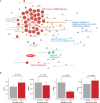Increased VEGF-A in solid type of lung adenocarcinoma reduces the patients' survival
- PMID: 33446784
- PMCID: PMC7809025
- DOI: 10.1038/s41598-020-79907-6
Increased VEGF-A in solid type of lung adenocarcinoma reduces the patients' survival
Abstract
The histological classification of lung adenocarcinoma includes 5 types: lepidic, acinar, papillary, micropapillary and solid. The complex gene interactions and anticancer immune response of these types are not well known. The aim of this study was to reveal the survival rates, genetic alterations and immune activities of the five histological types and provide treatment strategies. This study reviewed the histological findings of 517 patients with lung adenocarcinoma from The Cancer Genome Atlas (TCGA) database and classified them into five types. We performed gene set enrichment analysis (GSEA) and survival analysis according to the different types. We found six oncogenic gene sets that were higher in lung adenocarcinoma than in normal tissues. In the survival analysis of each type, the acinar type had a favorable prognosis, and the solid subtype had an unfavorable prognosis; however, the survival differences between the other types were not significant. Our study focused on the solid type, which had the poorest prognosis. The solid type was related to adaptive immune resistance associated with elevated CD8 T cells and high CD274 (encoding PD-L1) expression. In the pathway analyses, the solid type was significantly related to high vascular endothelial growth factor (VEGF)-A expression, reflecting tumor angiogenesis. Non-necrosis/low immune response affected by high VEGF-A was associated with worse prognosis. The solid type associated with high VEGF-A expression may contribute to the development of therapeutic strategies for lung adenocarcinoma.
Conflict of interest statement
The authors declare no competing interests.
Figures





Similar articles
-
Cancer-associated fibroblasts are associated with poor prognosis in solid type of lung adenocarcinoma in a machine learning analysis.Sci Rep. 2021 Aug 18;11(1):16779. doi: 10.1038/s41598-021-96344-1. Sci Rep. 2021. PMID: 34408230 Free PMC article.
-
Prognostic factors of acinar- or papillary-predominant adenocarcinoma of the lung.Lung Cancer. 2019 Nov;137:129-135. doi: 10.1016/j.lungcan.2019.09.026. Epub 2019 Sep 30. Lung Cancer. 2019. PMID: 31586770
-
Plakophilin-2 accelerates cell proliferation and migration through activating EGFR signaling in lung adenocarcinoma.Pathol Res Pract. 2019 Jul;215(7):152438. doi: 10.1016/j.prp.2019.152438. Epub 2019 May 13. Pathol Res Pract. 2019. PMID: 31126818
-
Basic fibroblast growth factor (bFGF) and vascular endothelial growth factor (VEGF) levels, as prognostic indicators in NSCLC.Eur J Cardiothorac Surg. 2004 Mar;25(3):443-8. doi: 10.1016/j.ejcts.2003.11.031. Eur J Cardiothorac Surg. 2004. PMID: 15019676
-
Current readings: pathology, prognosis, and lung cancer.Semin Thorac Cardiovasc Surg. 2013 Spring;25(1):14-21. doi: 10.1053/j.semtcvs.2013.01.003. Semin Thorac Cardiovasc Surg. 2013. PMID: 23800525 Review.
Cited by
-
Neuronal guanine nucleotide exchange factor promotes the axonal growth and cancer cell proliferation via Ephrin-A3/EphA2 axis in lung adenocarcinoma.J Transl Med. 2025 Feb 28;23(1):246. doi: 10.1186/s12967-025-06233-8. J Transl Med. 2025. PMID: 40022166 Free PMC article.
-
Bispecific antibody for lung cancer: mechanisms and clinical insights.Front Immunol. 2025 May 29;16:1572802. doi: 10.3389/fimmu.2025.1572802. eCollection 2025. Front Immunol. 2025. PMID: 40510353 Free PMC article. Review.
-
Baohuoside I Inhibits Tumor Angiogenesis in Multiple Myeloma via the Peroxisome Proliferator-Activated Receptor γ/Vascular Endothelial Growth Factor Signaling Pathway.Front Pharmacol. 2022 Mar 7;13:822082. doi: 10.3389/fphar.2022.822082. eCollection 2022. Front Pharmacol. 2022. PMID: 35341213 Free PMC article.
-
VEGF/VEGFR-Targeted Therapy and Immunotherapy in Non-small Cell Lung Cancer: Targeting the Tumor Microenvironment.Int J Biol Sci. 2022 May 29;18(9):3845-3858. doi: 10.7150/ijbs.70958. eCollection 2022. Int J Biol Sci. 2022. PMID: 35813484 Free PMC article. Review.
-
Correlation between the Expression of VEGF and Ki67 and Lymph Node Metastasis in Non-small-Cell Lung Cancer: A Systematic Review and Meta-Analysis.Evid Based Complement Alternat Med. 2022 Jun 28;2022:9693746. doi: 10.1155/2022/9693746. eCollection 2022. Evid Based Complement Alternat Med. 2022. Retraction in: Evid Based Complement Alternat Med. 2023 Dec 6;2023:9894125. doi: 10.1155/2023/9894125. PMID: 35800006 Free PMC article. Retracted. Review.
References
MeSH terms
Substances
LinkOut - more resources
Full Text Sources
Other Literature Sources
Medical
Research Materials

